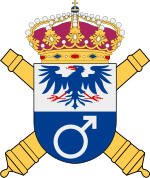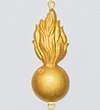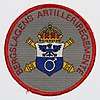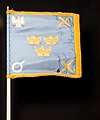Bergslagen Artillery Regiment
The Bergslagen Artillery Regiment (Swedish: Bergslagens artilleriregemente), designation A 9, was an artillery regiment of the Swedish Army, which was active from 1943 to 2000.
| Bergslagen Artillery Regiment | |
|---|---|
| Bergslagens artilleriregemente | |
 | |
| Active | 1943–2000 |
| Country | |
| Allegiance | Swedish Armed Forces |
| Branch | Swedish Army |
| Type | Artillery |
| Size | Regiment |
| Part of | Bergslagen Military District (1943–1991) Middle Military District (1991–2000) |
| Garrison/HQ | Kristinehamn |
| Motto(s) | Ultima ratio regum ("The last resort of kings") |
| Colors | Light grey |
| March | "Artilleri V" (Ström)[note 1] |
| Anniversaries | 9 September 4 December[note 2] |
| Insignia | |
| Branch insignia |  |
| Shoulder sleeve insignia (1986–2000) |  |
History
The regiment was created as part of a build-up of the Swedish Army during World War II, so that Sweden's neutrality could be protected. In accordance with the Defence Act of 2000, the regiment and the other artillery regiments of the Swedish Army were amalgamated into the Artillery Regiment, in Kristinehamn, which took the A 9 designation from the Bergslagen Artillery Regiment.
Heraldry and traditions
Colours, standards and guidons
When the regiment was raised it was presented with a regimental standard by Crown Prince Gustaf Adolf on 27 April 1945. The regiment also took over some traditions from the Uppland Artillery Regiment (A 5), including the march.[2] The colour was taken over from the Position Artillery Regiment (Positionsartilleriregementet, A 9).[3]
 The 1945 standard.
The 1945 standard. The guard standard
The guard standard
Coat of arms
The coat of the arms of the Bergslagen Artillery Regiment (A 9) 1977–2000. Blazon: "Per pale argent and azure; argent an eagle wings elevated and displayed azure, armed and langued gules, azure an iron sign argent. The shield surmoun-ted two gunbarrels of older pattern in saltire or. The gunbarrels may be sable".[4]
Medals
In 1944, the Bergslagens artilleriregementes (A 9) idrottsmedalj ("Bergslagen Artillery Regiment (A 9) Sports Medal") in gold (BergslartregidrottGM) of the 8th size was established. The medal ribbon is divided in blue and white moiré.[5]
In 1950, the Kamratföreningen Bergslagsartilleristers (A 9) förtjänstmedalj ("ervice Club of Bergslagen Artillery (A 9) Medal of Merit") in silver (KBergartSM) of the 8th size. The medal ribbon is of blue moiré with white edges and a broad white stripe on each side.[6]
In 1991, the Bergslagens artilleriregementes (A 9) förtjänstmedalj ("Bergslagen Artillery Regiment (A 9) Medal of Merit") in silver (BergartregSM) of the 8th size was established. The medal ribbon is of red moiré with a broad grey stripe on each side.[7]
 The Bergslagen Artillery Regiment (A 9) Sports Medal.
The Bergslagen Artillery Regiment (A 9) Sports Medal. Medal of the Bergslagen Artillery Regiment Shooting Association.
Medal of the Bergslagen Artillery Regiment Shooting Association.
Commanding officers
Regimental commander from 1943 to 30 June 2000.[8]
- 1943–1946: Carl Årmann
- 1946–1952: Axel Philipson
- 1952–1955: Thorsten Berggren
- 1955–1959: Fredrik Hård
- 1959–1964: Sven Sandahl
- 1964–1965: Nils Holmstedt
- 1965–1974: Sten Claëson
- 1974–1982: Gösta Mittag-Leffler
- 1982–1986: Carl Carlsson
- 1986–1992: Lars Carlson
- 1992–1994: Kjell Forssmark
- 1994–2000: Birger Almlöw
Names, designations and locations
| Name | Translation | From | To | |
|---|---|---|---|---|
| Kungl Bergslagens artilleriregemente | Royal Bergslagen Artillery Regiment | 1943-07-01 | – | 1974-12-31 |
| Bergslagens artilleriregemente | Bergslagen Artillery Regiment | 1975-01-01 | – | 2000-06-30 |
| Designation | From | To | ||
| – | 1811-02-05 | – | 1861-07-15 | |
| A 9 | 1943-07-01 | – | 2000-06-30 | |
| Location | From | To | ||
| Kristinehamn Garrison | 1943-07-01 | – | 2000-06-30 |
See also
Footnotes
- The march was inherited from Norrbotten Artillery Corps (A 5) and was established in 1953 by Army Order 33/1953. The march replaced "Schneidige Truppe" (Lehnhardt) which was used 1944–1952.[1]
- 4 December is saint day of Saint Barbara.
References
Notes
- Sandberg 2007, pp. 46, 75
- Braunstein 2003, p. 196
- Braunstein 2003, pp. 217–219
- Braunstein 2006, p. 33
- Braunstein 2007, p. 128
- Braunstein 2007, p. 83
- Braunstein 2007, p. 96
- Kjellander 2003, p. 249
Print
- Braunstein, Christian (2003). Sveriges arméförband under 1900-talet. Skrift / Statens försvarshistoriska museer, 1101-7023 ; 5. Stockholm: Statens försvarshistoriska museer. ISBN 91-971584-4-5. SELIBR 8902928.CS1 maint: ref=harv (link)
- Braunstein, Christian (2006). Heraldiska vapen inom det svenska försvaret [Heraldry of the Swedish Armed Forces] (PDF). Skrift / Statens försvarshistoriska museer, 1101-7023 ; 9 (in Swedish). Stockholm: Statens försvarshistoriska museer. ISBN 91-971584-9-6. SELIBR 10099224.CS1 maint: ref=harv (link)
- Braunstein, Christian (2007). Utmärkelsetecken på militära uniformer [Decorations on Swedish military uniforms] (PDF). Skrift / Statens försvarshistoriska museer, 1101-7023 ; 12 (in Swedish). Stockholm: Statens försvarshistoriska museer. ISBN 978-91-976220-2-8. SELIBR 10423295.CS1 maint: ref=harv (link)
- Kjellander, Rune (2003). Sveriges regementschefer 1700-2000: chefsbiografier och förbandsöversikter (in Swedish). Stockholm: Probus. ISBN 91-87184-74-5. SELIBR 8981272.CS1 maint: ref=harv (link)
- Sandberg, Bo (2007). Försvarets marscher och signaler förr och nu: marscher antagna av svenska militära förband, skolor och staber samt igenkännings-, tjänstgörings- och exercissignaler (in Swedish) (New ed.). Stockholm: Militärmusiksamfundet med Svenskt marscharkiv. ISBN 978-91-631-8699-8. SELIBR 10413065.CS1 maint: ref=harv (link)
Further reading
| Wikimedia Commons has media related to Bergslagen Artillery Regiment. |
- Antonsson, Rune; Månsson, Malte (1994). Bergslagens artilleriregemente 50 år (in Swedish). Kristinehamn: Bergslagens artilleriregemente. SELIBR 1902668.